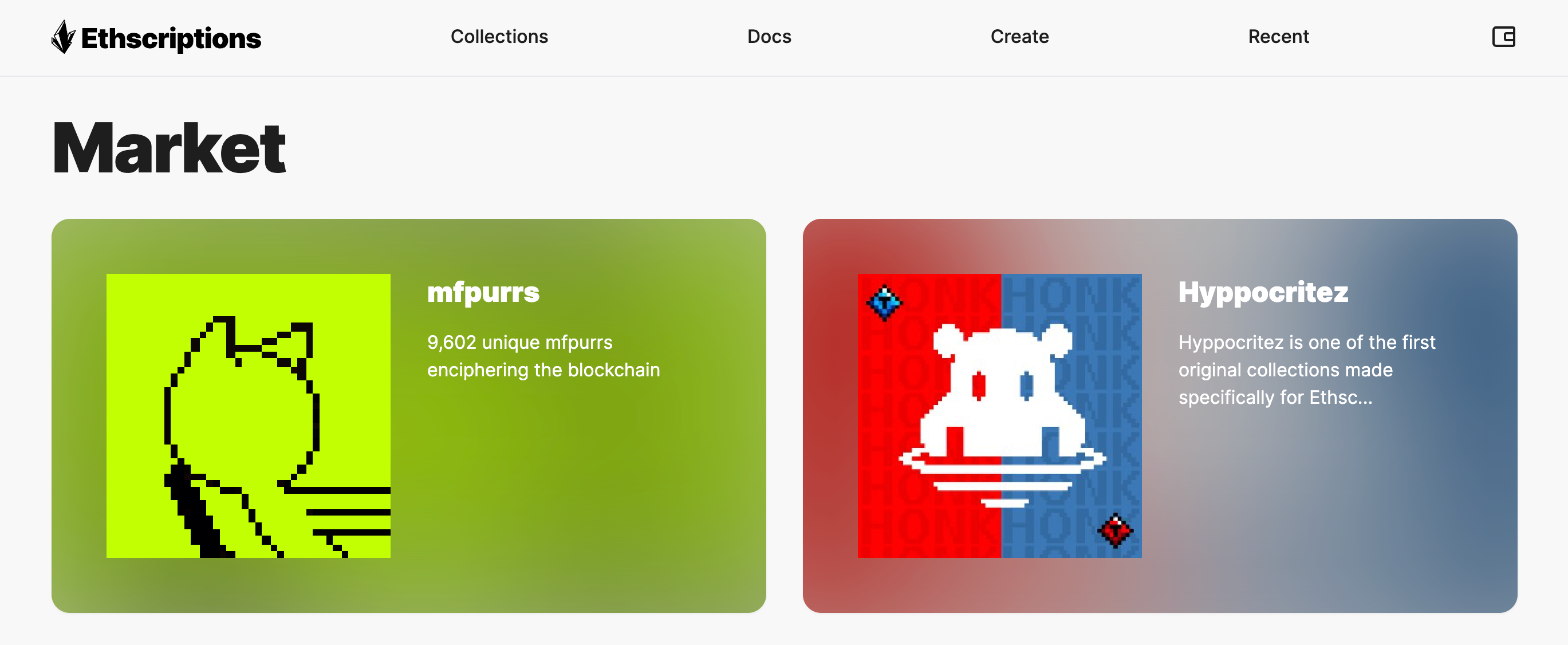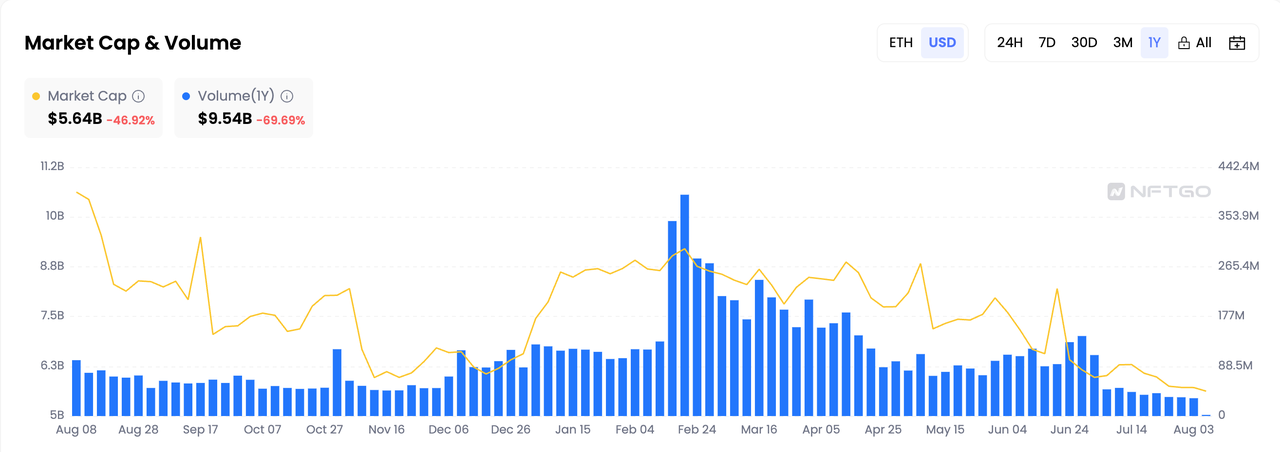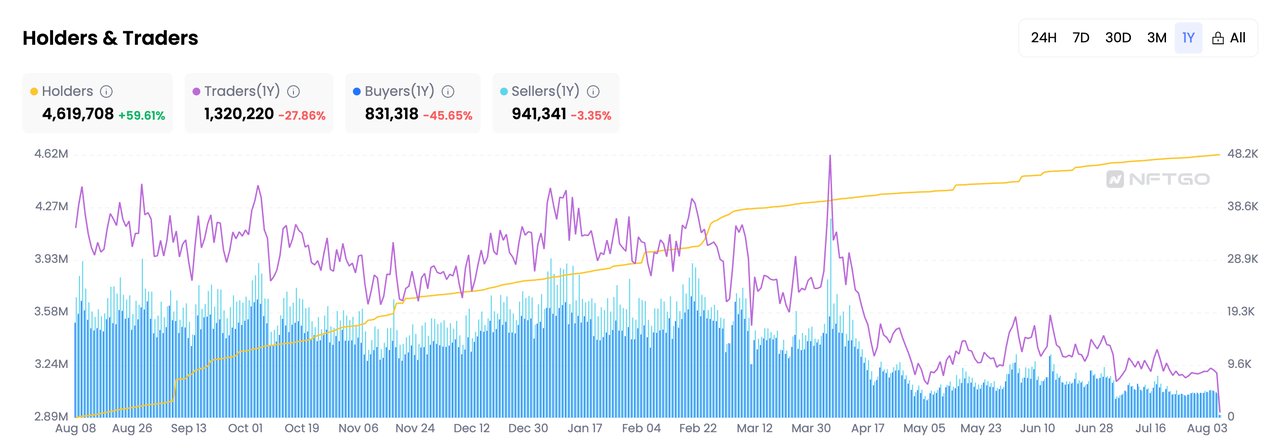After Ordinals, how does the Ethereum Inscriptions protocol Ethscriptions reshape the form of NFT assets?
How does Ethscriptions reshape NFT assets after Ordinals in the Ethereum Inscriptions protocol?With the development of the cryptocurrency market, the NFT sector has gradually formed its unique market. However, under the continuous impact of the cryptocurrency bear market, the development of the NFT sector this year has been full of difficulties and challenges. According to NFTGO data, as of August 7th, compared to last year, the total market value of NFTs is about $5.64 billion, a decrease of more than 46.92% in the past year; the total trading volume is $9.54 billion, a decrease of over 69.69%; and the number of traders is more than 1.32 million, with a decrease of 27.86%. Therefore, from a data perspective, the market value of NFTs is shrinking, and popularity and funds are continuously being lost.
Data source: NFTGO
Actually, although NFT projects such as Bored Ape Yacht Club (BAYC) and Cryptopunks have generated millions of dollars in transactions, driving the NFT frenzy at one point, the development of the NFT sector has always been controversial. For example, some people believe that since NFTs themselves have no intrinsic value, NFTs based on “value recognition” are more of a hype; or, currently, most NFTs are stored in centralized servers such as AWS and do not truly exist on the blockchain. Holders may need to deal with project parties suddenly going offline, unclear copyrights, and even the dilemma of NFT theft without recourse. However, it is undeniable that the development of any emerging field takes time, and these doubts are precisely the driving force behind the continuous development and innovation of NFTs.
- Bitcoin’s ‘buyer-to-seller ratio’ soars, indicating renewed bullish sentiment.
- Bitmain’s Market Director Lin Han PoW Ecological Construction, Preparing for the Next Bull Market
- IMF Working Paper How to Tax Cryptocurrencies?
Looking back to the beginning of this year, Casey Rodarmor released the Bitcoin Ordinals protocol. This protocol allows users to record different types of metadata (images, videos, PDFs, etc.) on satoshis, enabling them to create and store Bitcoin NFTs directly on the Bitcoin network, giving birth to the first Bitcoin network NFT. Currently, according to Dune data, the number of Inscriptions minted using Ordinals has exceeded 12 million in half a year.
Taking advantage of this new trend in NFT storytelling, Ethscriptions, the Ethereum Inscriptions protocol, has recently become popular in the crypto community. The following will introduce its advantages, challenges, and opportunities based on the operation process of Ethscriptions.
Introducing Ethereum Inscriptions – Ethscriptions
On June 17th, Ethscriptions, an Ethereum Inscriptions protocol developed by Tom Lehman, co-founder and former CEO of Genius.com, was officially launched. This is a new protocol that uses transaction-called data to create and share digital collectibles on the Ethereum blockchain.
Operation Process of Ethscriptions
Ethscriptions uses the Ethereum blockchain to store ownership information for each digital collectible, but the file size cannot exceed 96KB, and the protocol currently only supports images. However, the creators of Ethscriptions have stated that they will support various types of files in the future.
-
Create Ethscriptions
Successful transactions on the Ethereum network will create an Ethscription if the input data is a valid data URI. In this process, Ethscriptions make use of a feature called “Calldata”, which is data stored in Ethereum smart contracts. It writes data in Ethereum’s Calldata, which is cheaper and more decentralized than using smart contract storage.
URI refers to Uniform Resource Identifiers for different data. To ensure uniqueness and uniqueness, each URI is carefully designed and must meet the condition that no Ethscription in the previous block or in an earlier transaction in the same block has the same content. This clever method ensures that no other Ethscription shares the same information.
When someone creates an Ethscription, they are considered the creator of that Ethscription. The person receiving the transaction is referred to as the initial owner.
-
Transfer Ethscriptions
The owner can also transfer their Ethscription to someone else. Find the ID of the Ethscription you want to transfer, which is the transaction hash that created the Ethscription. Write the Ethscription ID in the “Hexadecimal” field and send the transaction to the recipient. When this transaction is processed, the recipient of the transaction becomes the new owner.
-
Track Ethscriptions
Currently, users can view all created Ethscriptions on the websiteethscriptions.comlaunched by Tom Lehman. The website also provides tools for creating Ethscriptions on the Ethereum blockchain.
🔗https://ethscriptions.com/

Differences and Similarities between Ethscriptions and Ordinals
The inscription models on Ethereum and Bitcoin ordinal numbers are likely to bring new trends to the NFT field. The creator of Ethscriptions once claimed that it can be compared to Bitcoin’s “Ordinals Inscriptions”. The two protocols have in common the way they define assets, which is to use Ethereum as a database and only write the data that defines the assets on Ethereum without using smart contracts. The differences between the two are as follows:
-
Different platforms. Ethscriptions run on the Ethereum network, while Bitcoin Ordinals run in the Bitcoin ecosystem. This platform difference will subsequently affect various aspects of their functionality and features.
-
Different operation modes of the protocols. Bitcoin Ordinals store smart contract transaction data on the Bitcoin network, while Ethscriptions use the Calldata feature to create inscriptions. In addition, Ethscriptions require each image to be unique, meaning that no two Ethscriptions can be the same. However, Bitcoin Ordinals allow the same image to be used on different tokens.
-
Different supported data sizes and types. Currently, the size of data that Ethscriptions support is limited to below 96KB, while Bitcoin Ordinals allow creators to form inscriptions of up to 4 megabytes. Although Ordinals support all types of digital files such as text, video, music, or games, Ethscriptions can only support images. However, in the future, it plans to eventually add different file types.
Ethscriptions: Constant Controversy, Innovation or Regression?
Overview of Ethscriptions Potential
Compared to traditional NFTs that rely on smart contracts, Ethscriptions is a new protocol that makes NFT assets more economical and decentralized. Since its inception, Ethscriptions has gained popularity in the community and has its own advantages:
-
Low user entry barrier. Users do not need extensive technical expertise to create and sell digital assets using the user-friendly navigation interface. This platform provides clear instructions and guidance for newcomers to the NFT world, creating a seamless user experience.
-
High transparency and security. The core of NFTs is a smart contract hosted on the ERC (Ethereum Request for Comment) chain. Traditional NFT platforms mostly provide on-chain verification while storing the NFT source file content off-chain. In contrast, Ethscriptions stores data on a decentralized network and utilizes the Ethereum blockchain to achieve transaction security and transparency. The ownership history of each NFT can be traced, preventing forgery or tampering while ensuring uniqueness.
-
Wide market reach. Backed by the leading Ethereum community, Ethscriptions is highly accessible and open to anyone with internet connectivity, allowing artists, collectors, and enthusiasts to efficiently explore and participate in the world of NFTs. Currently, Ethscriptions has gained support from popular NFT markets like OpenSea and Emblem Vault.
Challenges Faced by Ethscriptions
Despite the explosive growth of the Ethscriptions protocol in the Ethereum community, with tens of thousands of images and inscriptions engraved on the Ethereum network within a few hours, many community members believe that Ethscriptions is a step backward.
For example, crypto KOL Chainleft believes that Ethscriptions lacks innovation. Firstly, although the protocol was born as early as 2016 and people have been storing custom data or art in the call data for years, this technology is not groundbreaking and not a good way to store data.
In addition, the liquidity mechanism of Ethscriptions is not yet perfect. NFTs minted based on Ethscriptions currently need to be packaged into Ethereum’s ERC-721 or ERC-1155 NFTs using tools like Emblem Vault before being traded on OpenSea. This trading method still relies on Ethereum’s smart contracts and platforms like OpenSea.
Lastly, Ethscriptions needs improvement in terms of functionality and interaction. For example, there are limitations on supported data sizes and types, which restricts its ability to meet the diverse needs of NFT minting. Furthermore, Ethscriptions is different in that it does not include any smart contract logic, making it more challenging to combine with existing Ethereum smart contracts. How can the NFTs generated by Ethscriptions interact with existing Ethereum smart contracts? This may require the emergence of a series of new tools and platforms.
The Opportunities of Ethscriptions, Still Need Developers to Drive Innovation
The future of Ethscriptions may bring further innovation and development to the Ethereum ecosystem. As the NFT space continues to evolve, Ethscriptions will continuously develop to meet the ever-changing needs of users. A series of innovative tools and platforms, as well as a diverse range of applications, will continue to emerge. Here are some possible directions for the future development of Ethscriptions:
Enhanced features and functionality. Ethscriptions may introduce new features and extended functionality to provide creators and users with more immersive and appealing experiences. This could include support for other file types such as 3D models, augmented reality (AR) assets, and virtual reality (VR) experiences, opening up a world of possibilities for digital expression.
In addition, as the Ethereum network continues to evolve and scale, these advancements will enable Ethscriptions to handle larger volumes of transactions and provide a seamless user experience while maintaining the platform’s security and integrity.
Community-driven development. With its low barriers to entry, Ethscriptions can foster a vibrant community of creators, collectors, and enthusiasts who actively contribute to the platform’s development and improvement, cultivating a thriving ecosystem.
Integration of smart contract automation. Automated smart contracts can streamline transaction execution, reduce costs, and provide enhanced security and transparency, making Ethscriptions more efficient and user-friendly. Ethscriptions can integrate smart contract automation capabilities to simplify the process of creating, selling, and transferring NFTs.
Expanded market and ecosystem. Ethereum is currently one of the leading public blockchain ecosystems, and with the strength of the Ethereum platform and the development of its ecosystem, there is potential for dedicated platforms for buying, selling, and trading Ethscriptions, as well as collaborations with other NFT markets and platforms to increase the exposure and accessibility of minted products.
Conclusion
In summary, as demonstrated in the above analysis, the emergence of Ethscriptions provides a new form of asset for NFTs, offering developers and users a new choice in the encrypted NFT field. Whether for project parties, investors, developers, or users in the new field, making the project better is the optimal choice for “incentive compatibility”. Whether Ethscriptions will be a flash in the pan or a future trend, its development direction lies in the hands of every ecosystem developer, creator, and participant.
Reference articles:
https://docs.ordinals.com/
https://nftgo.io/analytics/market-overview
https://nftnow.com/guides/bitcoin-nfts-ordinals-inscriptions-explained-finding-buying-more/
https://crypto.news/ethscriptions-vs-ordinals-a-deep-dive-into-the-new-web3-phenomena/
We will continue to update Blocking; if you have any questions or suggestions, please contact us!
Was this article helpful?
93 out of 132 found this helpful
Related articles
- LD Capital Cryptocurrency exchanges are frequently deploying Layer2 solutions, carrying ambitious visions for the future market.
- Bankless Cryptocurrencies are entering the final cycle
- Bankless Co-founder The crypto market has entered the last cycle before maturity
- If room temperature superconducting materials can be realized, will it have a negative impact on the cryptocurrency market?
- Why the crypto community should pay attention to room-temperature superconductivity
- Changtui 7 major predictive indicators suggest that the market may be fully bullish.
- Wu said Zhou’s selection Hong Kong regulatory agency opens retail trading, Curve hacked, Binance US Department of Justice progress and news Top10 (0729-0805)








